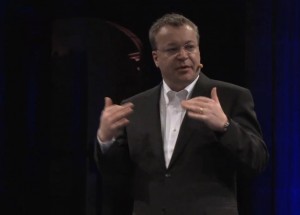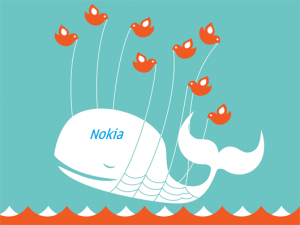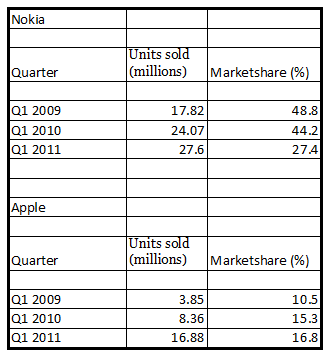It’s all Elop fault right?
 Now listen, Â some of you would like to blame Nokia’s nigh-dismal Q1 figures on the February 11th announcements or on Stephen Elop’s now hated “Burning Platform” memo and a few more still blame Microsoft from sending in their Trojan to take over Nokia’s mobile division in their mad quest to finally conquer the smartphone market (something they’ve been failing miserably at since 2006).
Now listen, Â some of you would like to blame Nokia’s nigh-dismal Q1 figures on the February 11th announcements or on Stephen Elop’s now hated “Burning Platform” memo and a few more still blame Microsoft from sending in their Trojan to take over Nokia’s mobile division in their mad quest to finally conquer the smartphone market (something they’ve been failing miserably at since 2006).
Well guess what guys and gals, it’s time to take off the blinkers. None among you can deny that Nokia have been floundering and failing miserably since the mobile market was so splendidly flipped on its head in January of 2007 by a certain other Steve. But before you come calling for my head, lets look at  just a few of the failures shall we?
Failures:
Failure #1:
The N96 – For whatever reason, Nokia decided it would be smart to produce an exact copy of the N95 8GB edition with the following brilliant improvements, DVB-H. Â No seriously, Nokia took a year+ to add the much desired feature of DVB-H to their flagship phone while keeping nigh-on the exact same physical dimensions (and design) as a device they had announced way back in Q4 2006. Worse still is the fact that they downgraded the CPU, graphics processing power, video processing power and a smaller battery. The supposed software improvements via the newer version of Symbian and S60 were buggy for the most part leaving users with a more expensive device with marginal at best and laughable at worst, improvements over a device from an earlier generation.
Failure #2:
S60 5th edition/Symbian^1- Say what you want, but the first implementation of Symbian on touch devices was clunky, counter-intuitive, sluggish and altogether not exactly a positive one. Value-for-money, in terms of durability, functionality and staying power as compared to its peers, I’ll say from experience that the 5800 (the first in the line) was definitely the best of its time. That however, doesn’t excuse the pitiful software that it was laden with. This in a time when iOS was really starting to find its feet in terms of feature/API parity and Android under HTC’s hard work and Sense UI was starting to catch the public eye. It took Nokia a good year and a half to get even marginally close to the user experience present on other competing platforms while it took the other platforms ~12 months to get feature parity(for most users) while utterly destroying Symbian^1 in terms of usability. It didn’t help that Nokia literally dragged Symbian dead and mangled through 2009 and pretty much all of 2010 with few changes on the software and even worse still the hardware which remained literally stagnant from 2008 until Q3 ’10.
Failure #3:
The N97 – I could have rolled this into the S60 5th edition/Symbian^1 but this device was a catastrophic fail in its own right. The fails started with the cheap hardware, ranging from anemic RAM and C: memory to the dastardly 434Mhz ARM11 CPU in a time when even the weakest Android’s were running 528 MHz and both Apple and Palm had transitioned to much more capable and powerful Cortex-A8 processors with functional GPU’s on board. There were also build quality issues but the GPS issue and camera cover scratching were definite deal breakers and that’s before looking at the shoddy, buggy software it shipped with. Coupled with the utterly false advertising campaign, this is probably the second to last nail in the coffin.
Failure #4:
Delays of the N8 – Now while it might seem like me nit-picking quite a bit, but the N8 was released to end-users much, much too late to have the sort of effect that Nokia wanted. Leaked in April of 2010 and extensively reviewed by a certain Russian blogger soon thereafter, it really was a device tailor-made for 2010. Had it been announced before the myriad super-powered Android devices and in particular the iPhone 4, Nokia could have made handsome inroads in the high-end smartphone market. Alas, the device was only made widely available after Nokia World 2010 in September and its sales were less than stellar in Q4 ’10.
Failure #5:
Meego – The idea of putting the two largest companies in their respective areas together and asking them to build an open source mobile operating system that would be the child of their previous offering in that regard sounded promising but there was always the chance that bureaucracy would get in the way, in addition to a few other possible issues. While Intel has stated publicly that “Nokia was perhaps the wrong partner to have picked”, having seen and used a Maemo device or two, Nokia actually having mobile products on the market and many of us still waiting on some sort of Intel chip on the market, I think I’d be forgiven for thinking that maybe Intel was the wrong partner for Nokia instead.
Failure #6:
Not pursuing Maemo – Maemo 5, while half-baked in many respects and not nearly a consumer-friendly product was categorically better than Symbian in almost every significant metric and that is far from hyperbole. While I might not be privy to the internal details surrounding its development, it was and still is better from many perspectives (in particular UI-wise) than Symbian in all iterations. Shoot, anything Nokia related that can get Engadget to say the words “brilliance” and “compelling” is worth looking at IMO.
All of these failures, some more significant than others point towards a common trend within the company. Maintain the status quo, do JUST enough, don’t change too much and more importantly get as much as you can value-wise for as little as possible effort-wise. Sadly enough, this was the regular course of events during OPK’s reign as CEO of Nokia.
Now that we’ve looked at the failures that befell Nokia under his reign, let’s look at the knock-on effects that we’ve seen since then.
Knock-On effects:

Brand Image:
Nokia’s brand-image due to it’s relation with Symbian amongst other things, is more or less tarnished in the public eye: Once seen as the paragon of innovation, hardware and functionality, that mantle is being taken over by players that nigh-on didn’t exist in the mobile landscape, and certainly not in the smartphone landscape. ZTE and Huawei are eating their lunch at the low end, Motorola, HTC, Samsung and Apple everywhere else.
Marketshare and Revenue positions both falling:
Deny all you want, but it is happening and has been happening since Q4 2009, OPK’s plan to price competitors out of the market clearly failed and now Nokia are left with a conundrum, raise prices and lose even more customers or leave prices as they are and unnecessarily cut into revenue. Many of you will cry foul saying that Nokia sold 24.2 million smartphones/converged devices last quarter (Q1) or 24% of all smartphones sold. Nokia has bled marketshare for the past 2 years without a shadow of a doubt and the stats prove it. According to Gartner the smartphone sales for Nokia as compared to Apple are as follows:
Now before you bring in the “Nokia still has marketshare argument”, Nokia as a Public Limited Company aims to make a profit on their sales. The average selling price of their (Nokia’s) smartphones just so happens to lag behind RIM and Apple for starters. Apple’s ASP is around US$622 per device sold, Nokia’s smartphones supposedly hover around the US$155 mark. If your product is equally as good as another’s and you’re selling for less, in this case 3-4 times less, you’d expect proportionally greater volumes. Clearly this is no longer happening due to lower consumer interest. It should be noted that current devices selling were all created and sanctioned  under OPK’s reign. As for Symbian^3 devices, 5 million in sales is respectable and whatnot but Apple sold 40% as many on a SINGLE carrier in the US in 1 quarter. Symbian is seemingly not wanted by consumers anymore :(.
Symbian and Maemo development behind the curve:
Lets be honest, Symbian has needed a UI overhaul since the first touch devices came on the market and nothing’s changed since then. Symbian Belle is supposed to be just that but by the time it’s actually released, it’ll likely be a year too late. Maemo was merged into MeeGo and similarly suffered from time-to-market related issues. Sure when it eventually comes out it’ll be great but chances are, the goalposts would have already moved. Plan ahead, beat the market to the punch; be revolutionary and not reactionary.
Elop’s mess to clean:
Now pretty much all of this was set in motion well before he took over the company and while Elop’s made one or two mistakes along the way like announcing WP7 move pretty darn early and likely worsening the Symbian play quite a bit. He hasn’t been liable for half of the crapstorm we’re now wading through. Many of us, myself included saw promise in things like Qt and Maemo 6 as well as a vertically integrated internal strategy built on Qt but it was simply not going to happen in a reasonable enough time-frame for the company to stay relevant.
If today’s new of a downgrade in outlooks for Q2 is any indication of things to come, life will get a helluva lot worse before it gets better for Big N and only time will tell if the brave gamble with Windows Phone pays off for them. To be fair to them they really had only two choices. Slowly fade into mediocrity and disappear or eviscerate themselves and start over, Symbian of course being the former and Windows Phone the latter.
Alas, all of this will probably fall on deaf ears. Keep blaming Elop for all the bad that we’re seeing now if it makes you happy. To me though, he’s simply tried to rectify an already untenable situation.
Category: Nokia







Connect
Connect with us on the following social media platforms.